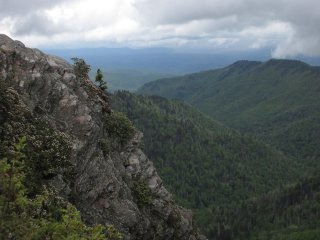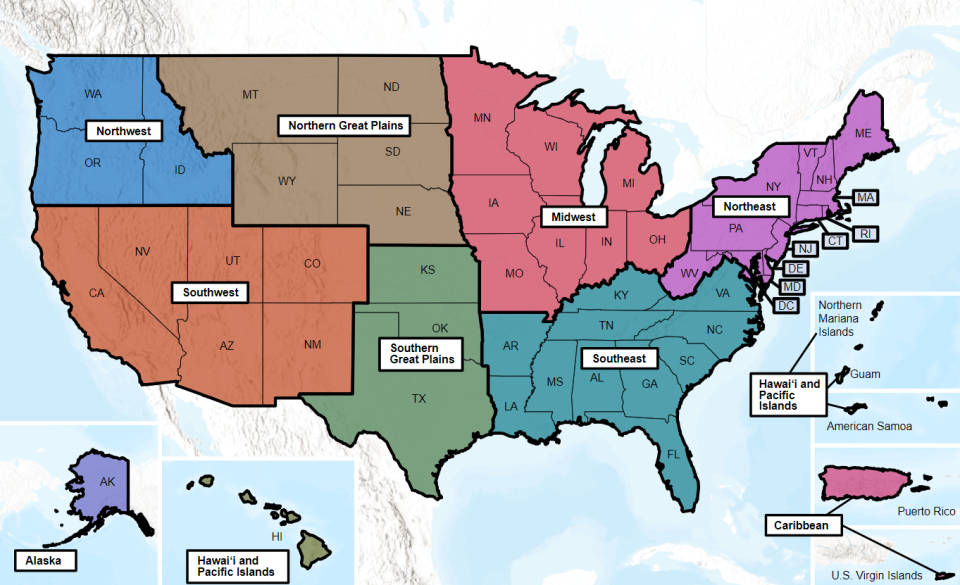Climate Change Connections: Tennessee (Great Smoky Mountains)
Climate change is impacting all regions and sectors of the United States. The State and Regional Climate Change Connections resource highlights climate change connections to culturally, ecologically, or economically important features of each state and territory. The content on this page provides an illustrative example. As climate change will affect each state and territory in diverse ways, this resource only describes a small portion of these risks. For more comprehensive information about regional climate impacts, please visit the Fifth National Climate Assessment and Climate Change Impacts by Sector.
On this page:
Introduction: The United States’ Most Visited National Park

Great Smoky Mountains National Park showcases Tennessee’s natural beauty and is the most visited national park in the United States.1 Part of the southern Appalachian Mountain range, the Great Smoky Mountains span the border between eastern Tennessee and western North Carolina. The park is the most biodiverse in the National Park system, with over 19,000 documented species of animals, fungi, plants, and other organisms.2 This variety is due to several factors, including a history of receiving species that migrated south away from glaciers and the wide range of habitats found in the Great Smoky Mountains, including four different forest types, grassy and shrubby meadows, and wetlands.3 The region now known as Great Smoky Mountains National Park is part of the ancestral home of the Cherokee People, who have lived in the region for millennia.
Great Smoky Mountains National Park gets its name from the clouds of blue mist, or “smoke,” that form over the mountains. The Great Smoky Mountains are an important tourist attraction and source of economic revenue in Tennessee. The park drew over 13 million visitors in 2023, its second busiest year ever.4 Local economies in Tennessee benefit from visitor spending. In 2022, Great Smoky Mountains National Park visitors spent $2.1 billion in nearby communities.5 However, the economic benefits from visitors are not guaranteed if access roads are impassable or if the iconic features of the park fundamentally change due to anticipated impacts from climate change.
Clouds and Climate Interactions

Although temperatures have increased nationally, Great Smoky Mountains National Park has not experienced substantial warming.6,7 Low-level clouds cool the region by reflecting sunlight and creating a temperature-buffering effect in the humid forest canopies, which has likely helped stabilize local temperatures.8,9 However, the average daily maximum temperature in Tennessee’s Sevier County, the gateway to the Great Smoky Mountains, is projected to increase by up to 6°F by mid-century compared to the average temperature for the period 1961 to 1990.10 In the mid-latitudes, which includes Tennessee, some climate models predict that warming will result in a decrease in the coverage of low-level clouds.8 A decline in cloud coverage would reduce the cloud immersion that is vital to the Great Smoky Mountains’ high-elevation spruce-fir forests.11 Additionally, reductions in lower-level clouds at the mid-latitudes reduces the amount of sunlight they reflect. Through this feedback loop, a decline in the Great Smoky Mountains’ low-hanging clouds could bring about further warming. Current conditions in the Great Smoky Mountains support high biodiversity, and changes to temperature and precipitation patterns could affect ecosystems in a variety of ways.3,6 Warming temperatures could have negative impacts on the park’s wildlife, such as the Great Smoky Mountains’ 30 species of salamanders that require moist conditions to survive.12,13
Climate Impacts: Extreme Rainfall Can Cause Dangerous Conditions
Extreme rainfall events in Great Smoky Mountains National Park cause flash flooding that can damage terrain and close park facilities. The Great Smoky Mountains are particularly prone to flash flooding because of their steep topography, which produces rapid runoff since water travels faster downhill over land and into streams and rivers.14 In recent years, flooding has affected many of the park’s roads and trails, leading to extended closures.6 In July 2022, the Greenbrier area of the park in Tennessee temporarily closed after the area received almost nine inches of rain within several hours.15 During the extreme rainfall event, flooding washed out multiple roads and trails, which remained closed for almost a year.15

In addition to flooding, extreme rainfall can trigger landslides. Mountainous terrain, like that of eastern Tennessee, is at greater risk for landslides when rain makes soil heavier and slipperier. Landslides can also disrupt the park’s transportation infrastructure.6 For example, heavy rainfall in February 2020 led to a massive overnight mudslide along the Spur, a Great Smoky Mountains parkway in Tennessee.16 The Spur was briefly shut down, with traffic detoured until the National Park Service could remove the roughly 500 cubic yards of debris.
Climate change can impact precipitation frequency and intensity. As average temperatures at the Earth’s surface rise, more evaporation and transpiration occur and add more moisture to the air, which in turn increases overall precipitation. In recent decades, more rainfall is occurring as intense heavy precipitation events.17 The number of days with extreme rainfall in Tennessee has been above average since 1990.18 The frequency and intensity of heavy rainfall events is projected to increase in the future.18
Taking Action: Educating and Preparing for a Changing Future
Addressing climate change requires reducing greenhouse gas emissions while preparing for and protecting against current and future climate impacts. Communities, public officials, and individuals in every part of the United States can continue to explore and implement climate adaptation and mitigation measures. The National Park Service and the communities surrounding the Great Smoky Mountains are taking steps to educate visitors about climate change and improve the park’s resilience with proactive planning and research, including:
- Education and outreach. Great Smoky Mountains National Park participates in the Climate Friendly Parks Program, which shares resources about climate-friendly practices with visitors.19 These practices help visitors understand different actions they can take to reduce their greenhouse gas emissions and mitigate the impacts of climate change, such as carpooling; taking one of the trolleys in Gatlinburg, Tennessee, to the park; or turning off lights and appliances in cabins or campers when not in use. Great Smoky Mountains National Park also has an Action Plan that describes the park’s emission reduction goals and the actions needed to achieve these goals.
- Research and monitoring. Researchers are monitoring animals and plants in the Great Smoky Mountains to better understand their responses to a changing climate.6 Visitors can support the research process by uploading photos documenting seasonal change to the National Phenology Network’s Nature’s Notebook Program.6 These observations help to provide information about long-term trends and capture the larger picture of how climate change is affecting species and seasonal changes in the Great Smoky Mountains.20
- Trail maintenance. The park’s trail crew and volunteers have restored many Great Smoky Mountains trails, making them safer for hikers and repairing past damage from landslides and erosion.21 The installation of drainage features and retaining walls during the renovations has also made trails more durable and resilient to heavy rainfall. Further investments in trail adaptation can help prepare the park for the projected increase in frequent and intense heavy rainfall events.
To learn more about climate change impacts in Tennessee and the Southeast region, see Chapter 22 of the Fifth National Climate Assessment.
Related Resources
- EPA Climate Change Indicators: Heavy Precipitation
- EPA Climate Change Indicators: U.S. and Global Temperatures
- Tennessee State Climate Summary 2022 (NOAA)
- Climate Change: Great Smoky Mountains National Park (NPS)
References
1 National Park Service. (n.d.). A wondrous diversity of life. Great Smoky Mountains National Park. Retrieved November 30, 2023, from https://www.nps.gov/grsm/index.htm
2 National Park Service. (n.d.). Nature & science. Great Smoky Mountains National Park. Retrieved July 18, 2023, from https://www.nps.gov/grsm/learn/nature/index.htm
3 U.S. Geological Survey. (n.d.). Ecology of Great Smoky Mountains National Park. Geology and Ecology of National Parks. Retrieved July 31, 2023, from https://www.usgs.gov/geology-and-ecology-of-national-parks/ecology-great-smoky-mountains-national-park-0
4 National Park Service. (n.d.). 325.5 million visits to national parks in 2023, 13 million visits at Great Smoky Mountains National Park. Great Smoky Mountains National Park. Retrieved August 6, 2024, from https://www.nps.gov/grsm/learn/news/325-5-million-visits-to-national-parks-in-2023-13-million-visits-at-great-smoky-mountains-national-park.htm
5 Flyr, M., & Koontz, L. (2023). 2022 national park visitor spending effects: Economic contributions to local communities, states, and the nation (Natural Resource Report NPS/NRSS/EQD/NRR—2023/2551). National Park Service. https://doi.org/10.36967/2299764
6 National Park Service. (n.d.). Climate change. Great Smoky Mountains National Park. Retrieved July 25, 2023, from https://www.nps.gov/grsm/learn/nature/climatechange.htm
7 EPA. (2024). Climate change indicators: U.S. and global temperature. Retrieved June 18, 2024, from https://www.epa.gov/climate-indicators/climate-change-indicators-us-and-global-temperature
8 Boucher, O., Randall, D., Artaxo, P., Bretherton, C., Feingold, G., Forster, P., Kerminen, V.-M., Kondo, Y., Liao, H., Lohmann, U., Rasch, P., Satheesh, S. K., Sherwood, S., Stevens, B., & Zhang, X.-Y. (2013). Clouds and aerosols. In T. F. Stocker, D. Qin, G.-K. Plattner, M. Tignor, S. K. Allen, J. Boschung, A. Nauels, Y. Xia, V. Bex, & P. M. Midgley (Eds.), Climate Change 2013: The Physical Science Basis. Contribution of Working Group I to the Fifth Assessment Report of the Intergovernmental Panel on Climate Change. Cambridge University Press. https://www.ipcc.ch/site/assets/uploads/2018/02/WG1AR5_Chapter07_FINAL-1.pdf
9 Stark, J. R., & Fridley, J. D. (2022). Microclimate‐based species distribution models in complex forested terrain indicate widespread cryptic refugia under climate change. Global Ecology and Biogeography, 31(3), 562–575. https://doi.org/10.1111/geb.13447
10 The Climate Explorer. (2023). Sevier County, TN. Retrieved July 25, 2023, from https://crt-climate-explorer.nemac.org/cards_home/?city=Sevier%2BCounty%2C+TN
11 Praskievicz, S., & Sigdel, R. (2023). Fog interception in spruce-fir and mixed northern hardwood forests of Great Smoky Mountains National Park, Southeast USA. Ecohydrology & Hydrobiology. https://doi.org/10.1016/j.ecohyd.2023.05.004
12 National Park Service. (n.d.). Amphibians. Great Smoky Mountains National Park. Retrieved November 30, 2023, from https://www.nps.gov/grsm/learn/nature/amphibians.htm
13 Milanovich, J. R., Peterman, W. E., Nibbelink, N. P., & Maerz, J. C. (2010). Projected loss of a salamander diversity hotspot as a consequence of projected global climate change. PLoS ONE, 5(8), e12189. https://doi.org/10.1371/journal.pone.0012189
14 Gaffin, D. M., & Hotz, D. G. (n.d.). A precipitation and flood climatology of the southern Appalachian Mountains. National Weather Service. Retrieved July 26, 2023, from https://www.weather.gov/mrx/heavyrainclimo
15 National Park Service. (n.d.). Greenbrier roads, trails, and picnic area temporarily closed due to flooding. Great Smoky Mountains National Park. Retrieved July 26, 2023, from https://www.nps.gov/grsm/learn/news/greenbrier-roads-trails-and-picnic-area-temporarily-closed-due-to-flooding.htm
16 National Park Service. (n.d.). Crews begin clearing mudslide on Spur. Great Smoky Mountains National Park. Retrieved November 30, 2023, from https://www.nps.gov/grsm/learn/news/crews-begin-clearing-mudslide-on-spur.htm
17 Marvel, K., Su, W., Delgado, R., Aarons, S., Chatterjee, A., Garcia, M. E., Hausfather, Z., Hayhoe, K., Hence, D. A., Jewett, E. B., Robel, A., Singh, D., Tripati, A., & Vose, R. S. (2023). Ch. 2. Climate trends. In A. R. Crimmins, C. W. Avery, D. R. Easterling, K. E. Kunkel, B. C. Stewart, & T. K. Maycock (Eds.), Fifth National Climate Assessment. U.S. Global Change Research Program. https://doi.org/10.7930/NCA5.2023.CH2
18 Runkle, J., Kunkel, K. E., Easterling, D. R., Stevens, L. E., Stewart, B. C., Frankson, R., Romolo, L., Nielsen-Gammon, J., Joyner, T. A., & Tollefson, W. (2022). Tennessee state climate summary 2022 (NOAA Technical Report NESDIS 150-TN). NOAA National Environmental Satellite, Data, and Information Service. https://statesummaries.ncics.org/chapter/tn/
19 National Park Service. (n.d.). Climate Friendly Parks. Great Smoky Mountains National Park. Retrieved December 1, 2023, from https://www.nps.gov/grsm/learn/nature/climate-friendly-park.htm
20 National Park Service. (n.d.). Citizen science. Great Smoky Mountains National Park. Retrieved December 1, 2023, from https://www.nps.gov/grsm/learn/nature/dff11-citizenscience.htm
21 National Park Service. (n.d.). Trails Forever program. Great Smoky Mountains National Park. Retrieved August 5, 2024, from https://www.nps.gov/grsm/getinvolved/supportyourpark/trails-forever-volunteer.htm

